- Visibility 366 Views
- Downloads 40 Downloads
- DOI 10.18231/j.ijpca.2023.028
-
CrossMark
- Citation
Intellectual property rights (IPR): An overview
- Author Details:
-
Manasi S. Zade
-
Firoj A Tamboli *
-
Apurva A. Salunkhe
-
Monali D. Kore
-
Amruta D. More
-
Yash R. Ghadge
Introduction
The legal rights that are given to the creator or the inventor to safeguard their work for a set amount of time are referred to as "intellectual property rights" (IPR). Promoting the creation of various intellectual commodities is the main goal of intellectual property laws. The earliest international accords to recognize the significance of the intellectual property were the Paris Convention for the Protection of Industrial Property (1883) and the Berne Convention for the Protection of Literary and Artistic Works (1886). Both agreements are governed by the World Intellectual Property Organization (WIPO).[1], [2], [3]
Objectives of IPR:[1], [4]
The term of "intellectual property" is that this area of content is a development of the mind or intelligence therefore its ownership rights are subject to legal safeguards in similarly to other kinds of property.The availability of legal protection for new inventions promotes the allocation of more funds for continued innovation.
It provides ease of doing business and encourages creativity and innovation.
Since intellectual property laws differ from one jurisdiction to the next, it is necessary to seek or gain IP rights independently in each interested region in order to acquire, register, or protect them.
The phrase "intellectual property right" (IPR) describes a multitude of legal rights pertaining to particular categories of information, terms, or other intangible assets that are expressed in their expressive form.
To enhance and modernize IPR administration that prioritizes customer service.
To encourage the development of IPRs.
To enhance and expand the organizations, personnel, and instructional, research, and skill-building capacity connected to IPR.
Types of Intellectual Property:[5], [4]
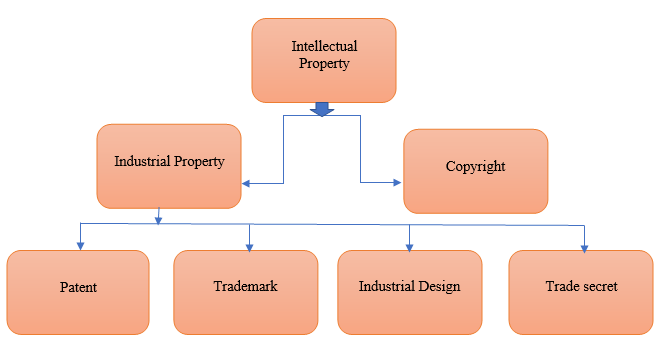
Industrial property
Patent
The patent represents one of the most significant forms of IPR. A patent is issued when an invention complies with the standards of general originality, non-obviousness, and industrial or commercial application. Patent protection is available for both goods and methods of production. A patent is an exclusive right granted to a creative thinking, such as a goods or technique that offers a fresh perspective on an issue or a brand-new technological solution. It gives the inventor who has a patent protection. "A government authority or license providing a right or title for a specific time period, especially the exclusive right to preclude others from creating, utilizing, or commercializing an invention," is how the term "patent" is described. The Indian Patent Act of 1970 stipulated that the patent had a validity period of 14 years from the date of filing, with the possible exception of preparation methods over pharmaceuticals and food products, in which the period of validity was either 7 years from the date of filing as well as 5 years from the date of the patent, whichever arrived initially. The insurance coverage is only available for a limited time, or 20 years. The patent holder has the power to select who may or may not utilize the innovation while it is covered by the patent.
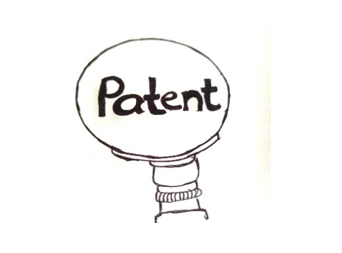
Types of patent
Utility patent
A utility patent is a form of patent that safeguards the creation of a brand-new or improved beneficial tool, process, or item. An example would be computer software, financial planning, tools and medical equipment, the chemical composition of biological forms, and technological breakthroughs. India is one among them. The utility patent is one of the most prevalent types of patents in India. This kind of patents provide protection for any innovation or invention in a good, process, or piece of equipment. This is typically granted for 20 years since the filing date of the patent application; nevertheless, monthly fees are required for keep the patent's validity.
Design patent
Design patents cover the appearance, structure, or arrangement of an object. It's essential that this novel aesthetic serve as an essential component of that product. For example, the Coca-Cola bottle from 1915 and the Statue of Liberty from 1879 both have design patent registrations because to their distinctive shapes, appearances, and textures. An object's appearance is protected by a design patent.
Plant patent
A plant patent is an intellectual property protection that prevents others from buying, using, or copying a novel and distinctive plant's vital characteristics. As the name suggests, a plant patent refers to a patent to safeguard a novel variety of a plant.
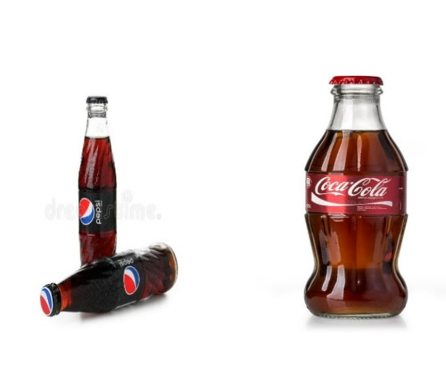

Trademark
A trademark is a distinguishing symbol used to identify an entity or business as a manufacturer or provider of a particular good or service. It could consist of one word or a collection of letters, numbers, or all three. It may be in the shape of text, words, numbers, phrases, symbols, designs, smells, colors, shapes, sounds, packaging, textures, or any combination of these things. It aids in assuring the customers that the products are of a particular type and quality. Additionally, it improves the manufacturer's or service provider's reputation. Because a product or service's nature and quality, as represented by its distinctive trademark, fulfill their needs, it promotes consumers in recognizing and purchasing it. The first registration period is for 10 years; thereafter, it may be periodically renewed.
Consider brands like Apple, a given name The Tata group of companies uses TATA for branding. Similar to the Mercedes and Nike swoosh logos.

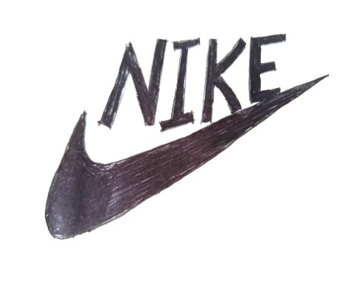
Industrial design
Industrial designs are the results of creative work that give products an aesthetic or formal appearance, and design rights are the rights that are granted to the owner of a legally registered design over novel or original designs. A component of intellectual property is industrial designs. The New Designs Act, 2000, which governs industrial designs in India, will be useful in keeping up with the fast-paced changes in technology and global advances. In general, the owner of a registered industrial design or a design patent has the right to stop others from producing, importing, or selling items bearing or embodying a design that is a copy, or essentially a copy, of the protected design, when such activities are carried out for profit. Industrial design protection has been given minimal criteria of protection under the TRIPS Agreement.
Trade secret
A trade secret is a crucial item of knowledge that is kept confidential and gives a company an edge over competitors.
Trade secrets are a form of intellectual property which involves formulas, processes, techniques, concepts, equipment, themes, and information collections that have an intrinsic value because they are obscure to the public or difficult to ascertain by other people, and which the proprietor takes reasonable measures to keep in secret. Intellectual property (IP) rights that are available for licensing or sale protect trade secrets. Trade secrets can take on numerous forms, such as an exclusive method, tool, style, structure, formula, procedure, technique, as well as strategy which has been utilized to provide a firm a benefit against competitors or add value for customers but is not readily apparent to outsiders.

Copyright
Copyright is the term used to define the rights granted to writers, painters, musicians, and other inventors for their "original" masterpieces of creativity or to musicians, artists, and broadcaster for the rights related to such works. The types of works covered by copyright laws include works of literature such as novels, poetry, plays, encyclopedias, media outlets, and computer programs; databases; movies, compositions for music, and dance performances; artistic creations such as drawings, paintings, photographs, as well as sculpture; architectural creations; and advertisements, maps, and drawings for technical purposes. The author is granted the only right to sell, publish, and reproduce any literary, musical, dramatic, artistic, or architectural work made by them. The lifespan of a copyright under public legislation usually ends 50 to 100 years after the creator's passing, depending on the jurisdiction where it was created.
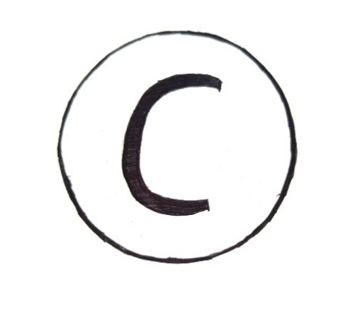
Duration of Intellectual Property Rights [4]
The period of validity of each patent shall be 20 years from its date of filing, whether a provisional or complete specification is included with the patent application. When a patent application is filed is the date of the patent. A trademark registration is regarded to have taken effect 10 years from the application filing date, which is considered as the registration date.
The typical lifespan of copyright is sixty years.
The registration period for Chip Layout Design is 10 years, beginning on the earlier of the dates of filing the application for the registration or the first commercial utilization of the design in any part of India, in a country party to a convention, or in a country designated by the Government of India.
Depending on the crop, registered varieties are protected for a range of lengths of time, from 18 years for vines and tree varieties to 15 years for different crops and existing varieties.
A geographical indication's registration is valid for ten years.
Procedure of Filling Patent Application
Who may apply for a patent ? [6], [7]
The people who may submit a patent application are listed in Section 6 of the Act. Any person who can prove that are an invention's original and authentic creator may submit an application for a patent at the patent office. But an assignee of the original and real inventor of the invention can obtain a transfer of such a right to submit an application. In this situation, the application must be supported by a declaration that the applicant is the original and true creator of the invention and a proof of application right. A patent application may also be submitted by the executor or administrator of a decedent who was entitled to a patent before his passing.
Why is a patent registered? [2], [6]
In order to avoid uninvited clients:
Creating or producing,
Applying,
Providing for sale,
Marketing,
Purchasing,
Distributing,
Licensing
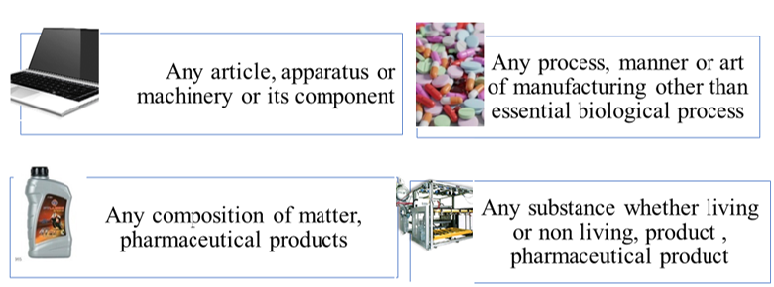
Inventions not patentable Sec 3:[2]
3(a): frivolous or clearly against established natural laws
3(b): violations of public order or morality that have a serious negative impact on human, animal, plant, or human health or the environment.
3(c): The mere formulation of an abstract theory, the discovery of any living thing or non-living substance occurring in nature,
3(d): the simple finding of a new version of a substance that is already recognized does not boost the chemical's already-known efficacy
3(e): a substance created by a straightforward mixing that just aggregates the characteristics of its constituent parts; or a method for creating such substances
3(h): a horticultural or agricultural technique
3(i): Any procedure for treating animals to make them disease-free or to boost their economic value or the value of their products falls under the definition of. This includes medical, surgical, curative, prophylactic, diagnostic, therapeutic, or other forms of treatment.
3(j): Microbes are not included, but seeds, species, and animal types are, along with essentially biological processes for development or reproduction of plants and animals in whole or in any portion, including microbes.;
3(k): a business or mathematical method, a computer program in and of itself, or algorithms
3(k): A literary, dramatic, musical, artistic, or other aesthetic creation.
3(m): merely a system, rule, technique for completing a mental act, or method-playing strategy
3(o): integrated circuit topography
3(p): An innovation that effectively duplicates or aggregates previously known qualities or conventionally known component(s)
New invention must meet the following criteria:[2]
Be unique;
Involve an innovative step;
Be applicable to industry; and
Not fall under the provisions of sections 3 and 4.
Relate to a procedure, a good, or both.
Forms for application for patent:[6], [8]
|
Form |
Title |
|
Form 1 |
Application for Grant of Patent |
|
Form 2 |
Provisional/Complete Specification |
|
Form 3 |
Statement and Undertaking Under Section 8 |
|
Form 5 |
Declaration as to Inventorship |
|
Form 9 |
Request for Publication |
|
Form 18 |
Request or Express Request for Examination of Application for Patent |
|
Form 26 |
A Patent Agent's or Any Person's Authorization in a Matter or Proceeding Under the Act |
|
Fees |
First schedule fees |
How and where to apply? [2], [6]
A paper application can also be submitted by person at the proper patent office, or a person can submit an online application for a patent. The first online filling in India began on July 20, 2007. Physical documents must be carefully filed within the geographical jurisdictions specifically stated by the applicant or, in the case of joint applicants, the applicant's first name.
The location where the invention originated as well as the applicants' place of business or residence are considered in appropriate patent offices. The foreign applicant, whose firm is not in India or is not domiciled in India, provides an address for service or the location of his patent agent business.
The Department for Promotion of Industry and Internal Trade, which is a government agency, oversees and grants all rights relating to patents in India through the office of the controller general of patents, designs, and trademarks (CGPDTM).
One patent office head in Kolkata and three patent office branches are currently located in Chennai, Mumbai, and New Delhi. Applications must be sent to the Kolkata Patent Office from locations not covered by the three patent office branches.
|
Patent office |
Territorial jurisdiction |
|
Kolkata, Head office |
Rest of India |
|
Mumbai, Office Branch |
Maharashtra,Gujarat, Chhattisgarh, Madhya Pradesh, Haveli, Goa, Daman and Diu & Dadra and Nagar. |
|
New Delhi, Office Branch |
Himachal Pradesh, Haryana, Rajasthan, Punjab, Uttar Pradesh, Uttarakhand, Chandigarh, Delhi, Jammu and Kashmir, Ladak |
|
Chennai, Office Branch |
Karnataka, Kerala, Tamil Nadu, Telangana, Andhra Pradesh, Pondicherry, Lakshadweep. |
Patent registration in India: The process [9]
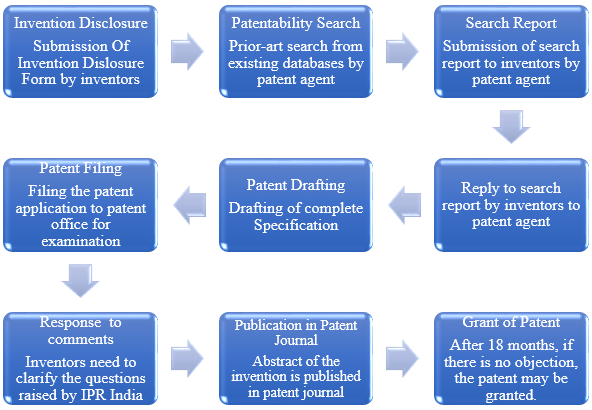
Steps for Filling Patent in India:[10], [11], [12]
Making sure the innovation is patentable by carrying out a search
An innovation must meet the conditions for patentability in India as outlined in The Patents Act before it can be protected by a patent. They involve the uniqueness of the invention's subject matter, the creative process as well as the invention's lack of obviousness, and the invention's fitness for application in the industry. Additionally, as stated in Section 32 of The Patents Act, some inventions are not patentable. The next important step is to carry out an in-depth investigation to verify the innovation's uniqueness. It is often accomplished by looking the database of the Indian Patent Office for published applications and ongoing patents. Depending on the scope of the invention, the search may also be done on overseas databases like the World Intellectual Property Organization or the US Patent and Trademark Office.
Drafting the patent application
Following confirmation of the Indian patentability requirements, the process of getting an application for patents in India involves creating a detailed application containing all of the requirements and claims.The applicant may start the patent application process at this point. For each patent application, Indian applicants must submit Form 2 of the patent specifications along with Form 1 of the Indian Patent Application. Depending on the level of development of the invention, applicants may select between provisional and comprehensive patent applications. It is best to submit a provisional patent application if the idea is still being tested because this gives you a twelve-months opportunity to finish the invention and submit full patent application.
It is crucial to include the required schematics, drawings, and a thorough description of the invention while filing an application for patents in India. The concept should be fully explained, along with how it varies from existing solutions. This is advised to seek the assistance of a patent agency or an attorney for patents to ensure that the patent application satisfies with all standards.
Filing the application for patent in India
Along with the required filing fee, the finished patent application must be delivered to the Indian Patent Office. Both offline and online applications can be submitted. The patent office will mail a receipt as proof of application acknowledgement. In addition to the patent application, there are many application forms that must be submitted, including:
Form 1: a request for the issuance for a patent;
Form 2: a description of the application's form, which might be provisional or complete;
Form 3: In accordance with Section 83, a commitment and statement regarding foreign applications must be provided if an equivalent application is also filed in another nation;
Form 5: A declaration of the innovation must be submitted along with a complete application and a working example of the invention;
Form 26: A form authorizing the agent must be filed if the candidate has chosen to permit an agent for filing the patent.
Form 28: Only those applicants who claim to be small businesses or start-ups must submit this form.
Publication of the patent application
After being submitted to the Indian Patent Office, a patent application is published in the official patent journal. Usually, it happens eighteen months after the application was submitted. If the applicant desires early publication, he must submit a request for an earlier publication in accordance with Form 9. Publishing may be prohibited in some situations, such as when an application is incomplete, the applicant wants a withdrawal, or there is an order of confidentiality under the Act on Patents. Through this publication, the public shall be enabled to read the application and express any objections or concerns.
Examining the patent application
Prior to issuing a patent, each request for patent protection is examined. The candidate must submit Form 18 to request an examination. Following submission, the patent officer examines the application to make sure it conforms with all applicable Indian patent rules and guidelines. If any objections are made, they are stated in detail in a document known as the First Examination Report (FER), which is produced after the officer conducts a thorough inquiry by looking at the pertinent inventions. The applicant must revise the application if there are objections, for which they can submit Form 4 to request an extension.
Grant of patent
If the application is deemed to be in order and all objections have been addressed, the Patent Office will award the patent and publish it in the Patent Office Journal. For a period of twenty years beginning on the date the patent application was submitted, a patent gives the owner the only right to use, manufacture, sell, or import the innovation in India.
Renewal of a patent
Every year, the patent holder must pay a fee for the renewal of the patent. The maximum period of time for which a holder can update the patent is 20 years from the application date for issuance of the patent.
Applications of IPR:[4]
The Indian government has granted the right to intellectual property as a means of preserving the caliber and standard of pharmaceutical products and services. To keep drug goods safe, pure, and high-quality, intellectual property rights are crucial.
Intellectual property rights are vital for assessing the stability and safety of products and are applicable to the manufacturing, pharmaceutical, analytical, chemical, and analytical and chemical industries. The concept of intellectual property applies to businesses, industries, and marketing.
IPRs are relevant in the fields of industry, science, literature, and the arts.
Intellectual property rights are applicable to NDA, ANDA, and INDA analysis of pharmaceutical formulations or drug products.
Intellectual property rights are relevant for characterizing, testing, and analyzing drug qualities and quality
It serves as a copyright function and can be used to protect the author's originality or uniqueness in their work. A unique right granted by the Indian government to preserve inventors' innovations is known as an intellectual property right.
It is essential to maintain the trade secret function in order to preserve patents or business-related data. For the purpose of identifying a product in a huge market, it is required has certification and an identification mark.
It is appropriate for preserving the usefulness, originality, and design of patented data. It is relevant for figuring out Indian law or Indian legal system.
It is crucial for determining straightforward industrial or ornamental designing and layout-focused semiconductor gadgets.
It is relevant for determining whether patent data is anticipated and whether it falls under previous art, which is done by IPR.
It is also relevant for determining whether the Indian Patent Act of 1970 was amended in 1999, 2002, 2005, and 2006.
It is useful for determining the processes for patent application and grant, patent revocation, and patent infringement, as well as for determining the processes for commercialization and patent licensing.
Conclusion
The Indian government grants intellectual property rights as a matter of government policy. It is evident that maintaining intellectual property and IPR calls for a number of actions and strategies, all of them must adhere to national laws in addition to global conventions and rules. Different intellectual property rights forms call for different management, organizing, and techniques, along with the participation of individuals with a variety of the subject matter skills, which includes engineering, technology, healthcare legal, financial, marketing, and economics. An invention's compliance with Indian patentability requirements, such as novelty, non-obviousness, and industrial applicability, is ensured through the patent registration process. An essential stage in preserving intellectual property rights in India is step-by-step patent registration. Each step in the process of registering a patent in India, from conducting patent searches to determining the novelty of the invention to drafting and filing the patent application, is crucial. The next step, the examination and prosecution phase, entails resolving examiner objections. The publication of the patent application makes the application open to public scrutiny and increases the likelihood that objections will be raised.
Conflict of Interest
Authors declares no conflict of interest.
Source of Funding
None.
References
- . . . [Google Scholar]
- . . . [Google Scholar]
- E Academy. Intellectual Property Rights: What Researchers need to know. 2021. [Google Scholar]
- S K Savale. Intellectual Property Rights (IPR). World J Pharm Pharm Sci 2016. [Google Scholar]
- AH Gaikwad. A study of intellectual property rights and its significance for business. J Computational Acoust 2020. [Google Scholar]
- V Choubey. Prosedure of filling a Patent application in India. . [Google Scholar]
- A Gupta. Patent: Procedure for filling an application. 2019. [Google Scholar]
- S Desk. Step by step guide on Patent Application. Retrieved from vakilsearch. 2023. [Google Scholar]
- Somasundaram. How to file an Indian Patent. 2022. [Google Scholar]
- S King. India: Patent Registration process in India: A Comprehensive Guide to filling and Prosecuting Patent Application. Retrieved from mondaq. 2023. [Google Scholar]
- A Laddha. Registration process for Patent under Patent Act. 1970. [Google Scholar]
- S Team. Step by step procedure for patent registration in India. 2023. [Google Scholar]
- Introduction
- Objectives of IPR:[1], [4]
- Types of Intellectual Property:[5], [4]
- Duration of Intellectual Property Rights [4]
- Procedure of Filling Patent Application
- Who may apply for a patent ? [6], [7]
- Why is a patent registered? [2], [6]
- Inventions not patentable Sec 3:[2]
- New invention must meet the following criteria:[2]
- Forms for application for patent:[6], [8]
- Steps for Filling Patent in India:[10], [11], [12]
- Making sure the innovation is patentable by carrying out a search
- Drafting the patent application
- Filing the application for patent in India
- Publication of the patent application
- Examining the patent application
- Grant of patent
- Renewal of a patent
- Applications of IPR:[4]
- Conclusion
- Conflict of Interest
- Source of Funding
